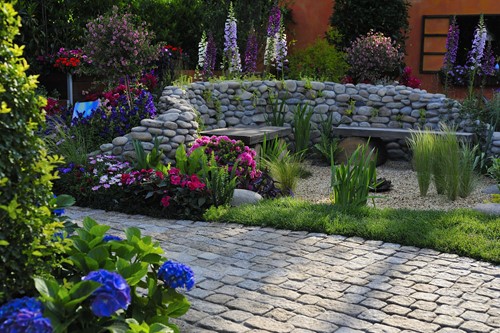
If you’re new to designing outdoor spaces it might be easy to get overwhelmed. Luckily, there are some key principles and guidelines that go into every landscape design no matter the size or location. Here we’ll go over the basic tips and concepts to consider when creating your own landscape design.
The easiest place to begin when designing a landscape is the concept of form following function. Whether you want it to be a venue for dining and entertainment, an escape for quiet contemplation, a place to play with pets and family or anything else, use that to guide your decision making. Be aware of what design choices would prevent you from using the space in the way you want. For instance, does the lack of shade make it uncomfortable to sit outside during the day? Are there too many garden beds and not enough free space to move around? Think of the function first and the form will follow naturally.
It’s crucial to understand and make a note of the space you are working with. Things like dimensions and microclimates are important to every design decision. You’ll need this information to know where the best place to plant trees or flowers are or the perfect corner for your barbeque pit. Pay attention to how the sun moves across the yard during the day and make a note of the areas that get full sun versus those that remain in shade. Air flow is also an important factor in comfort and design, so pay attention to the way the wind moves through—or if it doesn’t at all.
It’s easy to overcomplicate, especially in the brainstorming phase of your design. In order to avoid this, focus on specific priorities and build around them. For example, if creating a deck is the most important part of the yard, focus on that rather than get bogged down by details. Think in broad terms and put yourself in the space physically and mentally. Do you create a walkway all the way around the lawn or does it make more sense to cut through it? Is there a simple path back and forth to the inside of the home? Usually, the simplest answers to these questions will be the most effective in your design.
Focal points are an essential part of any design because they guide and determine the entire aesthetic and flow of the space. A focal point is where you want to draw the eye, so think about how you can create the best but most comfortable view. Your focal point can be a stone fire pit or an elegant water feature. It can even be something as simple as a retaining wall decorated with potted plants. The focal point should be the most aesthetically important part of the yard.
While there are guidelines, landscaping design is not an exact science. It takes equal parts practicality and creativity, and the possibilities are endless. As long as you keep these general concepts in mind you’ll be able to create the landscape of your dreams—one that looks and functions exactly how you want.

Judy Gibbons is a highly accomplished Realtor licensed in Illinois, Michigan, and Florida. With an impressive list of accolades and a wealth of experience, she has become a prominent figure in the Chicagoland real estate industry. Gibbons is also an American Dream TV host, showcasing local businesses and beautiful properties.
As a global real estate advisor, Judy is known for her ability to seamlessly connect extraordinary homes with extraordinary lives. She possesses an extensive knowledge of the market, and is committed to providing world-class service to her clients. Gibbons can assist you whether it is with luxury real estate transactions, investment properties, short term rentals, or helping first time buyer clients with tall heir real estate needs.
With over 20+ years of experience, give Judy a call today and discover the difference of working with a real estate advisor who is dedicated to helping you achieve your real estate dreams, wherever they may lead you.
Designations/Licenses: Certified Distressed Property Expert, Broker, GREEN
Town Coverage: Chicago, Illinois, Arlington Heights, Illinois, Barrington, Illinois, North Barrington, Illinois